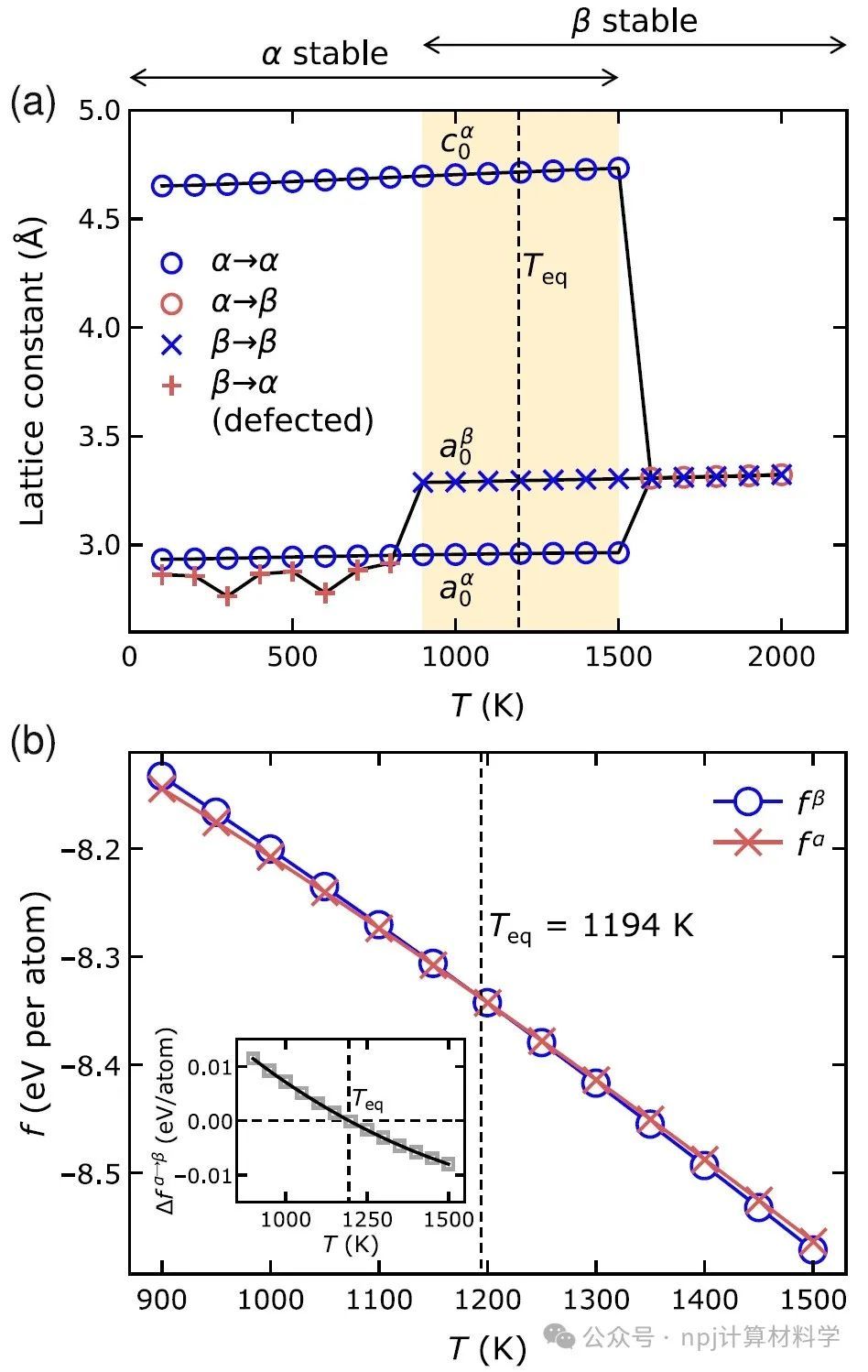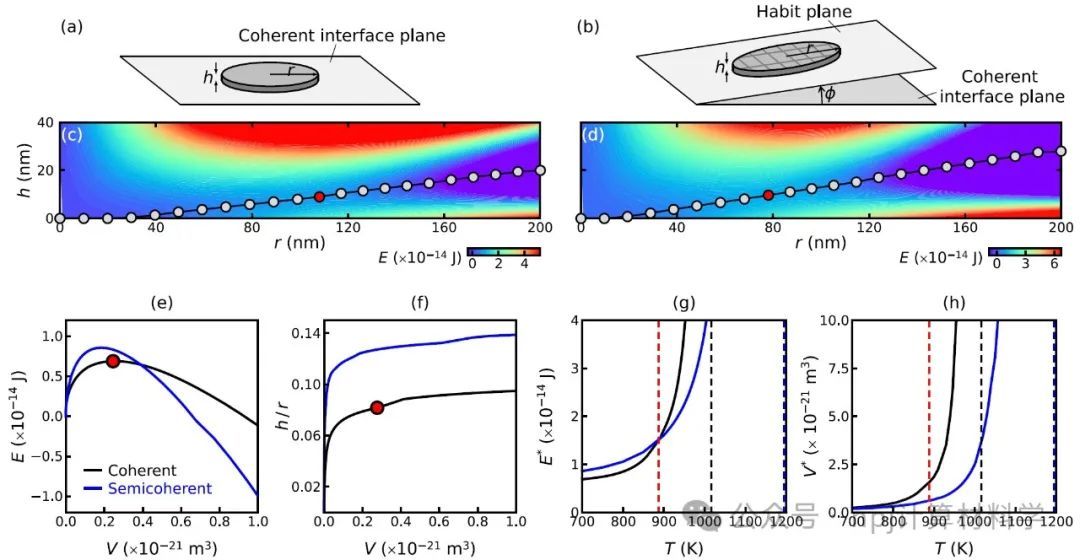钛合金因其卓越的性能和广泛应用,对其α/β微观结构的优化至关重要。界面能量是影响合金性能的关键,但直接测定其值极具挑战。新兴技术,包括热力学积分和基于DFT数据的神经网络模型,现已使得界面能量的精确计算成为可能,进而推动了材料设计和性能优化的新篇章。

Fig. 1 Temperature dependences of the lattice constants and free energies of bulk α and β phases.
由香港城市大学材料科学与工程系的Jian Han教授领导的团队,采用分子动力学、热力学积分以及经过密度泛函理论(DFT)训练的深度学习势模型,深入探讨了钛材料中α/β界面(即和))的结构和热力学特性。

Fig. 2 Schematic of the model for simulating coherent α/βinterfaces.
研究首先集中于分析钛的相干α/β界面的热力学性质,并考察其如何受到应变和温度的影响。随后,团队对半相干界面的结构和属性进行了细致审查,并将这些发现用于理解β基体中α析出相的成核及生长过程,也就是从高温状态开始的冷却过程。

Fig. 3 Temperature dependence of coherent α/β interface free energy.
该论文的关键发现包括:(1)成功预测了钛中最关键界面(相干和半相干)的自由能,这是首次以接近DFT精确度进行此类计算(值得注意的是,β相在0K下完全不稳定,因而在没有人为约束的情况下DFT无法直接计算);(2)模拟结果展示了半相干界面的平衡结构和本质的缺陷结构,这些结构解释了习惯面的普遍存在;(3)揭示了界面迁移的作用机理,并指出这一机理在不同方向(比如升温与降温)会导致界面迁移速率的不同;(4)这些精确的热力学和结构数据被用于可靠预测α-β相变冷却过程中析出相的形成。

Fig. 4 The α/β equilibrium temperature and coherent interface free energy under different strain states.
此项研究不仅为准确预测界面属性和运动提供了指导,还为理解和预测包括在低温下不稳定的相和相干性丧失情况下的析出行为提供了实用的参考。该文近期发表于npj Computational Materials 9: 216 (2023)。

Fig. 5 Schematic of the model for simulating semicoherent α/β interfaces.
Editorial Summary
Deep potential: Structure and thermodynamic properties of titanium alloy interfaces
Titanium alloys, renowned for their exceptional performance and wide-ranging applications, require optimization of their α/β microstructure for enhanced properties. The key to alloy performance, interface energy, presents significant measurement challenges. Emerging technologies, including thermodynamic integration and neural network models trained on DFT data, now enable precise calculations of interface energy, thereby opening a new chapter in material design and performance optimization.

Fig. 6 Semicoherent interface structure.
A team led by Prof. Jian Han from Department of Materials Science and Engineering, City University of Hong Kong, investigated the structure and thermodynamics of the α/β interface in Ti using molecular dynamics, thermodynamic integration and a DFT-trained Deep Potential.

Fig. 7 Disconnection lines in a semicoherent interface.
The authors first focus on the thermodynamic properties of the coherent α/β interface in titanium (i.e., and ) as a function of strain and temperature. Next, the authors examine the structure and properties of the semicoherent interface. This information is then applied to understand the nucleation and growth of α precipitates in a β matrix (i.e., cooling from high temperature).

The main findings in this paper are as follows. (i) The authors predict the free energy of the most important interfaces (coherent and semicoherent) in titanium. This represents the first such calculations with DFT-level accuracy (note that β phase is completely unstable at 0 K and hence inaccessible to DFT without artificial constraints). (ii) The simulations show the equilibrium structure of the semicoherent interface and its intrinsic defect structure that gives rise to the widely-observed habit plane. (iii) The authors demonstrate the mechanism of interface migration and that this mechanism gives rise to different interface mobilities in different directions (heating vs. cooling). (iv) These accurate thermodynamic and structural results are applied to make reliable predictions on how precipitation occurs upon cooling through the α-β phase transition.

Fig. 9 Nucleation of α phase from β phase.
This paper provides a roadmap for accurate prediction of interface properties and motion as well as precipitation in any system, including in systems with phases that are unstable at low temperature and in systems where loss of coherency occurs. This article was recently published in npj Computational Materials 9: 216 (2023).

Fig. 10 Semicoherent α/β interface migration.
原文Abstract及其翻译
Coherent and semicoherentα/β interfaces in titanium: structure, thermodynamics, migration (钛中的相干与半相干α/β界面:结构、热力学及迁移特性)
Siqi Wang, Tongqi Wen, Jian Han & David J. Srolovitz
Abstract
Theα/β interface is central to the microstructure and mechanical properties of titanium alloys. We investigate the structure, thermodynamics and migration of the coherent and semicoherent Ti α/β interfaces as a function of temperature and misfit strain via molecular dynamics (MD) simulations, thermodynamic integration and an accurate, DFT-trained Deep Potential. The structure of an equilibrium semicoherent interface consists of an array of steps, an array of misfit dislocations, and coherent terraces. Analysis determines the dislocation and step (disconnection) array structure and habit plane. The MD simulations show the detailed interface morphology dictated by intersecting disconnection arrays. The steps are shown to facilitate α/β interface migration, while the misfit dislocations lead to interface drag; the drag mechanism is different depending on the direction of interface migration. These results are used to predict the nature of α phase nucleation on cooling through the α–β phase transition.
摘要
α/β界面是影响钛合金微观结构和力学性质的关键因素。在本研究中,我们利用分子动力学模拟、热力学积分方法,以及基于密度泛函理论训练的高精度深度学习势能模型,详细探讨了温度和失配应变条件下钛的相干与半相干α/β界面的结构、热力学性质以及迁移行为。研究发现,一个处于平衡状态的半相干界面由一系列台阶、失配位错以及相干的平台构成。通过分析,我们确定了界面上位错和台阶(断连)的阵列结构及其习惯面。分子动力学模拟揭示了由断连阵列交互作用形成的复杂界面形态。研究表明,台阶结构促进了α/β界面的迁移,而失配位错则产生了对界面迁移的阻力,具体的阻力机制取决于界面迁移的具体方向。这些发现帮助我们预测了在α-β相转变冷却过程中α相成核的特性。
